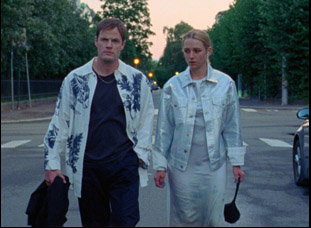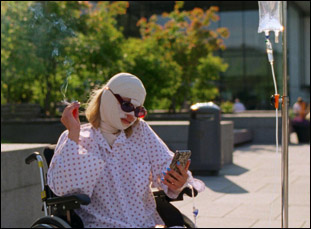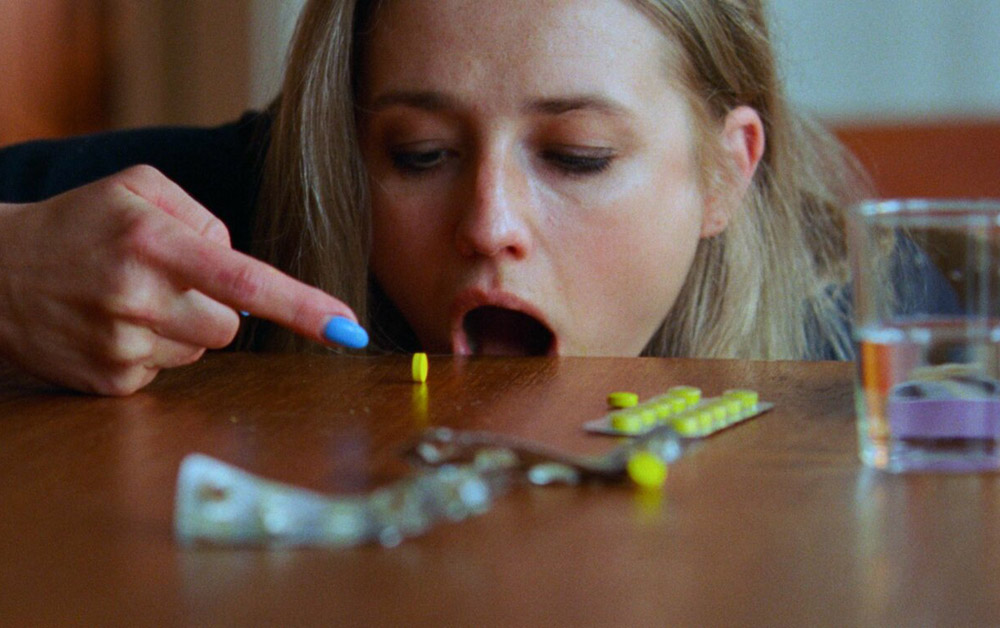Signe (Kristine Kujath Thorp) can’t help but look a bit sad at the start of “Sick of Myself” when no one takes notice of her, though it’s clearly better that they don’t with a waiter running past her to catch her boyfriend Thomas (Eirik Sæther) after he’s absconded a bottle of $2300 wine from a restaurant and . The two might be able to afford it, given Thomas’ stature as a rising artist in Norway with avant garden exhibitions filled with chairs, but the fact that he’d steal so brazenly may give him even more artistic cred and Signe is also apt to take the wrong lesson away when she literally can’t get arrested for her role in the dine and dash, craving the attention that her partner receives even though her anonymity has protected her from spending the night in jail.
This tortured way of thinking begins to show on the outside in Kristoffer Borgli’s exquisitely warped comedy in which Signe considers inducing a skin condition on herself with medication that might bring the kind of interest from others that she’s always wanted, with the results revealing as much about the attention economy around her as herself. It may or may not be a path to happiness for her, but it does prove to be a darkly delightful showcase for its fearless star Thorp, who last turned heads talking to the strange beast kicking inside her in the 2021 comedy “Ninjababy,” and Borgli, who is at once poking fun at the pretensions of the art scene while exhibiting an eye that leaves no question he’s the real deal, letting the deeply uncomfortable and elegantly devised comic setpieces grow in potency without the relief of a cut to break the tension or the nudge of a music cue.
Borgli may preside over a takeover of Norwegian media in “Sick of Myself” when Signe becomes a media sensation, or at least it seems so in her own mind — one can never be sure as the writer/director blurs the lines, but he looks to be taking over the entire world soon enough, already having shot a follow-up, “Dream Scenario,” with Nicolas Cage and Michael Cera and the backing of producer Ari Aster and A24. With the filmmaker criss-crossing the East and West Coast attending screenings at the IFC Center, in New York this Wednesday and Thursday and at the Nuart in Los Angeles on Friday and Saturday to kick off a national theatrical tour, he graciously took some time to talk about how a seed of the idea grew over the course of the last several years, finding a worthy co-conspirator in Thorp and how reality and fiction began to blur not only for the main character, but himself as life started imitating reality.

It’s true. It was just a vague image of a blonde girl in Oslo with a skin disease in my head, which was nagging at me and bugging me constantly. It wasn’t until around 2016, I noticed a very visible shift in the fashion industry, where inclusivity became the most important element of their marketing and suddenly thought combined with that image I have in my head, there’s a story that makes sense in the current cultural moment, so it started becoming like, how do I get this person into the fashion industry? Is there a story there?
It seems very tied to the arts scene in Norway, but you made a wonderful short in 2017 about moving to Los Angeles. Was this always set there?
Yeah, I moved to L.A., and half the reason was the weather. Norway is pretty brutal half the year and of course, it makes sense for a filmmaker to move to L.A. But I didn’t have any footing in the town, so I was still thinking of Norwegian movies and the Norwegian film industry [because] I knew how that worked and [once] I had an idea for a film, the title in my head was “Sick of Myself” and I thought it could be an American story or a Norwegian story, but it was so much easier for me to write an application to the Norwegian Film Fund for a writing grant that determined the story a little bit. But as soon as I was in it, I was feeling inspired by more of an L.A. personality — heavily ambitious, slightly opportunistic, and maybe a heavy dose of narcissism. That was almost a stereotype or an exaggeration of people that I met in L.A. more than in Norway, so in a way, I think it helped to write a Norwegian movie in L.A. to set the tone a bit.
Was there an inspiration for the artist being a designer of chairs?
Yeah, this is a well-known story in Norway now because it’s inspired by real events. There was a group of people that I heard stories about stealing expensive design furniture and wines for years. They found a clever way to abuse the trust we have in a Norwegian society, where you can just go into a hotel lobby during an event and just take things and leave and nobody says anything because we’re such a polite society. They did this for years, and I thought “Wow, that is so fun to put in a movie.”
They were actually all caught by the police when we were in production, and they came out with surveillance video camera footage that made all the headlines online in Norway, so when we premiered the movie, the newspapers started writing about the overlap with the real stories and what the movie was about. One article even suggested that the whole court case against these guys was a marketing ploy set up by us because they couldn’t really believe the timing. It was too perfect.
This seems like an impossible part to cast, given all the character needs to pull off tonally. What sold you on Kristine Kujath Thorp?
It actually thought it was going to be very easy because the script has so many demands of an actress and I was inspired by a type of a person that I rarely actually see in Norway [that it would be attractive as a challenge]. But having to cast that person, it became a trickier process because she was so exotic and so foreign to a Norwegian sensibility, I saw in the casting that it was not coming off as authentic. It didn’t feel real, so I started thinking maybe I’ve written an impossible character for a Norwegian person to play, and when Kristine did her first audition I felt a sense of relief, [thinking], “Okay, it is possible,” and not only a relief, but then as we kept going I saw that she is Signe. She’s making her more nuanced and more detailed and bringing her to life. In many ways, I don’t think this movie could have been made without her, actually.

Yeah, one of the aspects that Izzi Galindo, the prosthetics designer, and I were talking about when creating this fictitious skin disease was that we wanted it to not interfere with the emotional communication and the expressiveness of a face, so we wanted to keep it out of the eyes and away from the mouth, so that the actor could emote without problems but of course it was still a layer that [Kristine] constantly felt during the process. What she’s said is that it helped her with this idea that she was supposed to have a skin disease [when] it was doing things to her face that felt really alien and strange, so I think it helped her put her head into this idea.
Anders Danielsen Lie has a great scene, playing a doctor as he actually is in real life. Did he actually come to mind for that reason for that part?
Yeah, we talked about the idea that a lot of this movie takes place in Signe’s head, and we were thinking because Anders is a real-life physician, you could end up in a position where you’re sitting in a doctor’s office and he is the one telling you the news or reading off of a chart and the film doesn’t really reveal if Anders is [actually playing himself or someone else] in the movie. If she’s having a fantasy where Anders is her doctor, that would be cool or actually horrible because the news that he’s bringing is so heartbreaking — maybe even more [so if coming] from a cool actor, so there was an opportunity to do some meta layering with Anders playing a doctor. He said himself, “This is the first time I’m actually playing a doctor in a movie.”
You also have a funeral scene that I wouldn’t want to spoil the context of, but it’s quite elaborate for what ends up being a punchline. I love that you’d go so far for a joke, but was it difficult to hold your ground to stage a scene that big for just one payoff.
It’s as though you were on set that day, or leading into the pre-production [because] it’s not a huge budget and I wanted to shoot on 35mm and we had to cut corners and make decisions on what do we actually film, and as you say, this is a pretty big setup for a joke. But it felt like an important piece to have in there, so I was fighting for that joke and the way staged it in the end was mostly inviting people that we knew. Half of my family is in that funeral and when we’re shooting it you know I didn’t reveal to anyone what the nature of that scene is going to be, so you know my family comes in and they think they’re a part of like a sad scene in the movie. Once they saw it at the premiere, they were like, “You used us for this weird fantasy!” But I’m glad you caught that because it’s an ambitious joke.
Were there things that once you got in the edit that you thought were funny that turned out sadder once you got there or vice versa?
More than anything, it was the sudden turns that the movie is making and on set, they were all separate moments, like “Today we’re shooting something funny and tomorrow we’re shooting something sad,” and in the edit, there’s not more than five seconds between those two moment, so I saw the kind of whiplash effect the sudden turns of tone had and I wasn’t sure if it was gonna land. But the more test screenings we did, I felt assured that people were able to hang on and follow the turns and twists, and in the end the movie carved out its own little space of tonality that I haven’t seen before, so I’m proud of that.
“Sick of Myself” opens on April 12th in New York at the IFC Center, April 14th at the NuArt Theater and expands across the country starting April 21st. A full list of cities and dates is here.




